- Home
- Dick Francis
Lester: The Official Biography Page 23
Lester: The Official Biography Read online
Page 23
He rode with longer leathers out at exercise and for trial gallops, but found the very short leathers beneficial to the horse for racing: the jockey's weight is poised above the horse's shoulder, where it causes least interference to the horse's action.
When Lester was first a jockey there were only about eight big races each year; now there are at least twenty-five.
He says he always got tense before the Derby, especially if he had any sort of chance, and reckoned that it probably helped because when he's tense he thinks faster, but it became impossible to live in twenty-five states of tension each year, and he tended to be less and less affected by big occasions. His great asset, anyway, had always been his capacity to keep cool in any form of stress and to go out to the most demanding examination with his brain functioning clearly. Stage-fright wasn't a problem.
Anxiety to succeed ... always, yes.
The anxiety, as every jockey knows, wasn't for his own sake alone, but for the owner's, the trainer's, the lad's and that of everyone else whose thought and work had gone into producing a horse ready to run for its everlasting reputation.
The training path to the Derby is fairly well marked. A colt that has shown speed and willingness as a two-year-old gets himself entered for the big race, and entered also for the Two Thousand Guineas.
The first two classics occur early in the season -too early, Lester thinks-leaving a scant five weeks for preparatory three-year-old races. There is only time really for one outing, and only four races in the calendar at present are of sufficient class to be considered true trials. If a colt does well, or at least isn't disgraced, in one of these, he'll take his place in the Two Thousand Guineas at the beginning of May at Newmarket.
Newmarket, where Lester has lived since his marriage in 1960, is a Suffolk country town set on a bleak, almost treeless heath scoured by winds off the North Sea. An unforgiving place for thoroughbreds, cold in the spring, hard and testing. If the weather's bad, the thousands of horses trained there face extra difficulties in developing.
(Blame King Charles II. All his fault. He loved the town and held court there, making hapless foreign ambassadors travel uncomfortably northwards by coach to present their credentials; probably, who knows, on the racecourse itself. In the 1660s, he made Newmarket the headquarters of the new sport of horse racing, and so it has remained ever since.)
The Two Thousand Guineas is run on the Rowley Mile (after King Charles II's nickname, "Old Rowley") which is straight, wide, undulat ing, bare and searching.
Only a very fit horse can win. The distance, one mile, is only two-thirds of the Derby, but the Two Thousand Guineas winner is almost automatically made favourite for Epsom.
The programme for fillies is a replica of the colts'. A preliminary test, then the 1-mile One Thousand Guineas at Newmarket, then at Epsom the llh-mile Oaks. Lester thinks fillies are harder to train, and in spite of his understandings with Petite Etoile, Carrozza, Park Top, Dahlia and the others, he preferred to ride colts.
He also preferred riding on the other course at Newmarket, the July Course, used chiefly in midsummer. "It's warmer," is the succinct reason. Like everyone with only a paper-thin insulating layer of subcutaneous fat, Lester feels the cold.
When he was young and struggling painfully against his own weight, he used to get extremely tired by the end of a hard race. He would ride all out to win, and maybe lose, and think exhaustedly that he'd got to go straight out and do it again ... and again. By the end of a busy afternoon, if he'd been concerned in several close finishes, he hardly had the strength to walk to his car.
This went on throughout his twenties, and it wasn't until he reached thirty that he reckons he arrived at his full physical stamina. At roughly the same time, his body weight stabilised at 8 st. 61bs., a balanced compromise at last between what was normal and what he wanted. At one time he had touched 10 st.2 lbs., but from thirty onwards he never put on more than a pound or two during periods of comparative inactivity, and says he could have ridden twenty hard races in a row and then sprinted to his car.
He weighed himself every day at home but didn't go to the extreme of carting scales along with him abroad. He can tell his weight, he says smiling, by the waistband of his trousers.
After the rigours of the Guineas meeting, but before the Derby, there is Chester week.
Chester is a circular track almost completely on the turn, with a very short 1-furlong straight. The form book gets all upset at Chester because of the turns. Some horses like it there but don't do well afterwards; others can't act there at all.
"You often get three-year-olds going to Chester," Lester says, "who have never galloped round a turn in their life. Two-year-old races elsewhere are mostly straight, and if they're trained at Newmarket, the training gallops are all straight, too. When they get to Chester, half of them don't know what to do."
Horses can either gallop round turns or they can't, he says. A horse can't be taught how to turn; either it comes naturally, or he's awkward. Sometimes a horse can turn easily one way but not the other-like Never Say Die. Smaller horses can turn more easily, very big ones seldom can. But if a big horse can, like Rheingold, he'll do well.
At Chester, although one wouldn't think so, it's possible to come from a long way back and get up to win. It's possible, Lester says, because horses tend to run races at a faster pace there because it's a small track, and if you know this and you're riding a horse that can turn, you can increase the speed even more at the right point and win.
It's best to be drawn with a low number in every race there, which puts one on the inside of the left-handed track. There are seldom more than fourteen runners in most races because of the lack of room, but more are allowed in the Chester Cup. Chester is a meeting Lester always enjoyed.
From Chester to Epsom. "Whoever thought of putting that racecourse where it is must have been an idiot," Lester says. "If it wasn't for the Derby, no one would run a good horse there. A lot of it is downhill. Horses aren't supposed to gallop downhill.
It's not so bad if the going is good or soft, but if it's hard, Epsom can break a horse down." That said, he adds, "There's nothing wrong with Tattenham Corner. It looks sharp, but it isn't. Horses turn well there; they hardly notice it.
"The ideal way to win the Derby is first of all to be drawn in the middle, or middle to outside. The horses on the inside have to go faster after the start to keep their position, and those on the outside have a job to close in. The large size of the field most years is in itself the first problem. The middle horses have the better chance to be where they need to be, which is towards the right-hand side of the track for a couple of furlongs, so gaining the advantage of the early right-hand bend. The runners then gradually come back to the left, and it is at this point that it's necessary to be in a good position. On a horse with a bit of speed one can reach and keep a good place here, in the first ten.
"The order then usually doesn't change much until Tattenham Corner. On the run down towards the corner there may be one or two bad horses dropping back from in front, which one has to miss, and round the turn there will be one or two more dropping back. Coming into the straight, the winner will be in the first six.
"From there, it depends on what the horse likes and what he can do. If he can run flat out for the last three furlongs, that's the place to start accelerating from. If he can only go for a furlong and a half, it's useless to start too soon. If he doesn't like to be in front very long, one has to wait until the final two hundred yards. If the horse can't quicken all that much, he has to be brought to the front early on."
The Derby was one of the few races Lester preferred not to win along the rails. Even with a horse like Sir Ivor, who had to be covered up until the last minute, he preferred to win away from the rails, not only to avoid being shut in but because the ground slopes in towards the rails quite sharply and can upset a horse's balance crucially at the worst moment.
"The Derby nearly always goes to an experienced horse (though Morst
on had run-and won -only once before his big day), because it is a rough, tough race. There are a lot of runners, there's fierce competition and no one gives an inch. If a horse has run only twice beforehand, he may react nervously, and only a horse that can get in there and have a go will win."
Oddly enough, excitable horses do well at Epsom. Empery, The Minstrel, Nijinsky, all sweated there before they turned their temperaments to explosive speed.
After Epsom, Royal Ascot. A good track, Lester says; the straight perhaps a shade too short. He had the shape, distance and desirable speeds of all the races there so clearly in his mind that he was top (or joint-top) `rider at the Royal meeting eighteen times. On each occasion since 1979 he was presented with a handsome lidded crystal vase. Nine of them stand in glittering rows on his bookshelves, and one on the coffee table contains books of matches for lighting cigars.
Ascot, Lester says, has the best jockeys' changing-rooms in the country. Ascot also, at the July meeting, holds the country's best race.
This, he reckons, is the King George VI and Queen Elizabeth Diamond Stakes, which is roughly England's equivalent to the Prix de 1'Arc de Triomphe. By the time the "Diamond" Stakes is run, the horses have sorted themselves out and one knows the really good ones. Then, too, top three-year-olds run against top four-year-olds and upwards, which makes it very fast and a great test of the best horse overall. It may not have the absolute prestige of the Derby, but these days it offers more in prize-money.
Lester won it seven times.
Of the other big tracks, he thinks Newbury the fairest and best: a really superb racecourse. It can accommodate large fields, and the ground is always good.
Kempton is great to ride on, though not as popular with the public as it should be.
The evening meetings there (Lester didn't like evening racing much) offer races that are probably easier to win than anywhere else, chiefly because a lot of trainers don't like evening meetings either.
Sandown, where the Eclipse is run in July, has a stiff uphill finish. One can easily get into trouble with that, Lester says, and also one has to remember and allow for the fact that the winning line seems to be at an angle, and the horses nearest the stands will be favoured if there's a close finish on the more-used round course. The straight 5-furlong track up the middle of the course is stiff too, but the result is easier to judge with the naked eye.
In late July there is Glorious Goodwood, with everyone in a holiday mood and many jockeys and their families staying the week in seaside hotels.
Lester says the dilemma of whether or not to water the Goodwood course in the summer heat sometimes results in the field on the round course crossing right over away from the watered and then rained-on part of the track and racing on drier ground against the stands' rails, which makes the distance covered longer and cuts up the ground used for the straight races. Watering is always a problem on the hilltop of the Sussex South Downs.
In between the big race meetings, there are of course dozens at other scattered tracks, many of which Lester went to often, and where he liked to ride, places like Lingfield, Haydock and Nottingham. Salisbury, with its springy downland turf, was built by one of his ancestors, a Cannon of Stockbridge.
In August, there's York, one of Lester's favourites. There too in later years, there was an award for the top jockey of the August meeting, which Lester won several times.
You can't fault the place, he says. It is one of the great tracks. The Benson and Hedges Gold Cup has been a pinnacle race of the season, but since Benson and Hedges have withdrawn their support, the race will have a different sponsor and title in future.
And so to September and the St. Leger meeting at Doncaster. On the straight course there, Lester says, a good draw is essential, the higher numbers on the stands' rails having the better chance, but in the St. Leger, on the round course, it doesn't matter.
Most of the racecourses nowadays have saunas to help with jockeys' weight problems: the one installed at Doncaster didn't work for several years because the electric wiring in the weighingroom couldn't deliver enough current. Satirical letters of protest flew in a barrage from the Jockeys' Association to the hapless Clerk of the Course who could make no decision as it's a council-run track, and the sauna stood there, mute and cold for some years. It is all right now though.
All through the year, the pattern changes. Horses come and go, some emerging, some fading, some returning. It's impossible for a horse to stay at the very top of his form for the whole seven and a half months.
"Quite often you think a horse is going to be a big challenge," Lester says. "Then when you get to the races, you have a look at him and you can see he's not going to trouble you.
"I think jockeys see this more than the people who look after the horses at home, because those people don't see the change as much as someone seeing the horse maybe once a week, or every two weeks. You see a horse at his peak, and you know what that looks like, you know how he should be. Then at other times you can see he's lost weight or he's too fat, and you know he won't win. Towards the end of the season especially, you see horses that have lost their condition. It's very hard to describe it to someone who doesn't really know what you're talking about, because to most ordinary people every horse looks the same."
-
23 Travels
LESTER saw the whole world as his racetrack, and with the ability to match the vision he donned his silks in a total of thirty-three countries outside Great Britain.
The results in winners of this truly astonishing globe-trotting are as follows:
Argentina
3
Australia
19
Austria
0
Bahrein
2
Belgium
4
Brazil
1
Canada
1
Denmark
3
France
352
Germany
27
Greece
11
Holland
0
Hong Kong
29
India
8
Ireland
176
Italy
36
Jamaica
11
Japan
0
Jersey
2
Kenya
1
Malaysia
30
New Zealand
7
Norway
7
Puerto Rico
0
Rhodesia
3
Singapore
45
South Africa
19
Spain
5
Sweden
7
Switzerland
0
Trinidad
1
USA
12
Venezuela
0
The minimum total of overseas races won is 821. For principal races won in each country, see the Appendix. The real significance of this long tribute to stamina and versatility is that for every six winners scored in Britain, Lester rode another overseas.
His easy embrace of other countries stemmed perhaps from the example of his grandfather, Ernie, who lived and raced for many years in France. Lester has always felt particularly at home there, and except for England preferred riding there to anywhere else.
After the First World War, a good many English racing jockeys and trainers settled in France, their names-Carver, Head, Cunnington, Bartholomew, Palmer-persisting to this day. Many of these families still speak English fluently, and Lester has had no language problems in France. He reads French himself better than he speaks it, but sign language makes up for what he can't say. Many racing terms, anyway, are the same in both languages, and enquiries (those unavoidable hurdles) are conducted for the English in English.
Lester says that when
he first went to ride in France there were some very excitable jockeys who were the roughest riders in the world. It was to deal with the wilder excesses of this tribe that the French Jockey Club, during the 1970s, brought in severe new interpretations of the rules. There was to be no more selfish criss-crossing during races: everyone was to race in a dead straight line; and if keeping straight meant losing the race, too bad.
For some time, the suspension rate rose to the point where trainers found it difficult to find a good jockey in possession of his licence. "Eight days, eight days, all the time," is how Lester describes it. In the end, and as a result, the French Jockey Club made racing literally straight.

 Bolt
Bolt Proof
Proof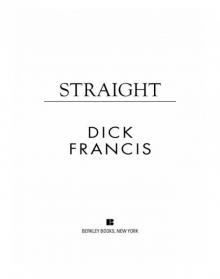 Straight
Straight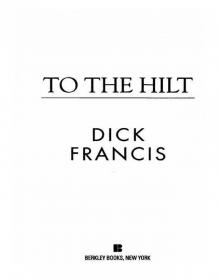 To the Hilt
To the Hilt High Stakes
High Stakes Come to Grief
Come to Grief Odds Against
Odds Against Knock Down
Knock Down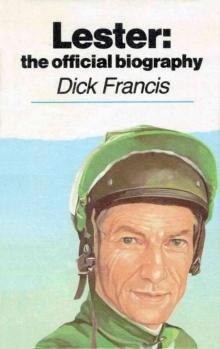 Lester: The Official Biography
Lester: The Official Biography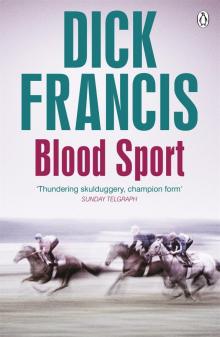 Blood Sport
Blood Sport Trial Run
Trial Run Comeback
Comeback Second Wind
Second Wind The Danger
The Danger Under Orders sh-4
Under Orders sh-4 Break In
Break In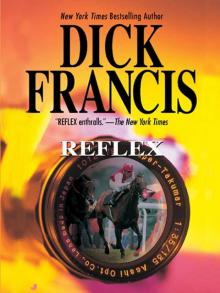 Reflex
Reflex Dead Heat
Dead Heat Dick Francis's Damage
Dick Francis's Damage The Edge
The Edge Wild Horses
Wild Horses Longshot
Longshot Slay Ride
Slay Ride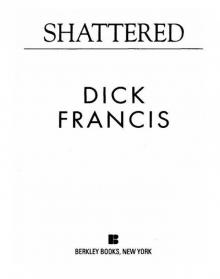 Shattered
Shattered Banker
Banker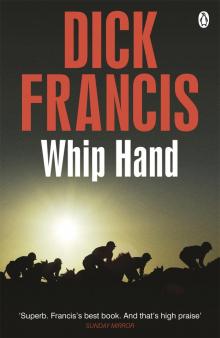 Whip Hand
Whip Hand Even Money
Even Money Driving Force
Driving Force Decider
Decider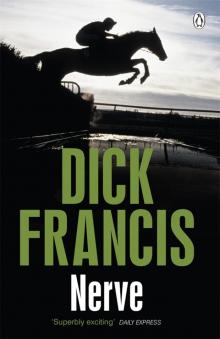 Nerve
Nerve Hot Money
Hot Money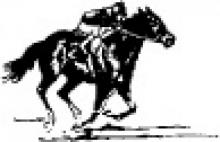 Field of Thirteen
Field of Thirteen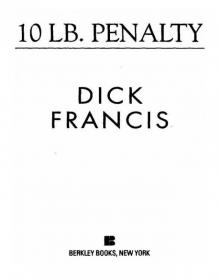 10 lb Penalty
10 lb Penalty Dead Cert
Dead Cert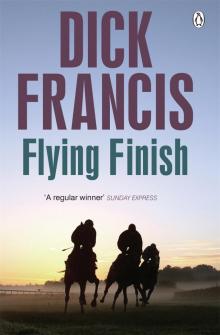 Flying Finish
Flying Finish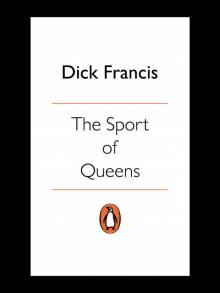 The Sport of Queens
The Sport of Queens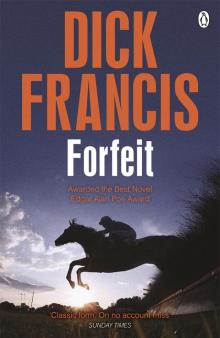 Forfeit
Forfeit Smokescreen
Smokescreen Twice Shy
Twice Shy Silks
Silks Enquiry
Enquiry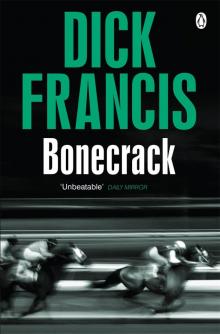 Bonecrack
Bonecrack For Kicks
For Kicks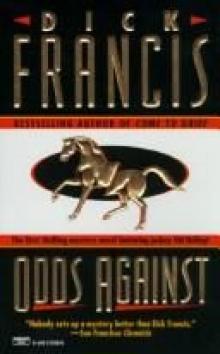 Odds against sh-1
Odds against sh-1 Rat Race
Rat Race Crossfire
Crossfire